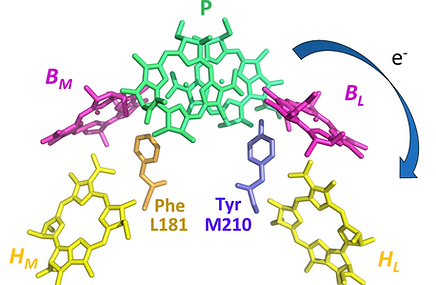Photosynthetic Reaction Centers

Blue arrow indicates direction of electron flow along L branch. Tyr at M210 is labeled in blue and its symmetry-related counterpart, Phe at L181 is shown labeled in gold.

Crystallographic structure demonstrating 3-iodotyrosine (IY) insertion by amber suppression at site M210 in the reaction center with two orientations.

Electron transfer kinetics of RCs with the M204E mutation where a putative hydrogen bonding interaction near BL had a dramatic impact on rate, decreasing from the 4 ps lifetime of primary charge transfer seen in WT RCs to the 36 ps lifetime fit shown above.
The photosynthetic reaction center is the heart of biological solar energy conversion. Nearly all known life relies on photosynthesis to convert solar energy into chemical energy, either directly or indirectly. Since the reaction center (RC) is central to this conversion, it has been optimized over billions of years to perform highly efficient and controlled photo-induced electron transfer. Our lab has a long-standing interest in understanding excited state energy and electron transfer in RCs. The bacterial RC studied in this lab (like its eukaryotic counterpart, PSII) consists of two branches of chromophores, which serve as electron shuttles. When excited, the special pair of bacteriochlorophylls (P) passes an electron to the bacteriopheophytin (HL) in the active branch of chromophores in ~3 ps, with near unity quantum efficiency. The three-dimensional structure of the RC exhibits a high level of symmetry with two possible, seemingly equivalent, pathways for electron transfer. Nonetheless, electron transfer only occurs along one branch of chromophores, breaking the symmetry and this is known as unidirectional electron transfer.
Our most recent work on RCs focuses on this initial electron transfer process. Why is it unidirectional? What is the role of the accessory bacteriochlorophyll (BL), which lies between P and HL?
To answer these questions, we seek to understand the role of the protein in stabilizing charge transfer intermediates. To assess the effect of the protein environment on energetics we have recently established a system for non-canonical amino acid incorporation into photosynthetic proteins [321]. This now gives us the ability to dissect the role of key protein residues by their replacement with analogues which possess subtly different electronic or steric properties. Using the same technology, we are also genetically encoding site-specific probes for electron transfer based on the vibrational Stark effect. These will give us alternative perspectives on the mechanism of electron transfer and its coupling to charge reorganization in the protein, that have previously been inaccessible.
[321] "Genetic Code Expansion in Rhodobacter sphaeroides to Incorporate Noncanonical Amino Acids into Photosynthetic Reaction Centers", Jared Bryce Weaver and Steven G. Boxer, ACS Synth. Biol., 7, 1618-1628 (2018). [pdf]
[301] “Putative Hydrogen Bond to Tyrosine M208 in Photosynthetic Reaction Centers from Rhodobacter capsulatus Significantly Slows Primary Charge Separation”, Miguel Saggu, Brett Carter, Xiaoxue Zhou, Kaitlyn Faries, Lynette Cegelski, Dewey Holten, Steven G. Boxer, and Christine Kirmaier, J. Phys. Chem. B, 118, 6721-6732 (2014). [pdf]